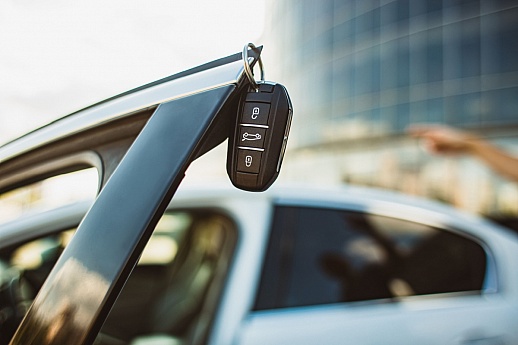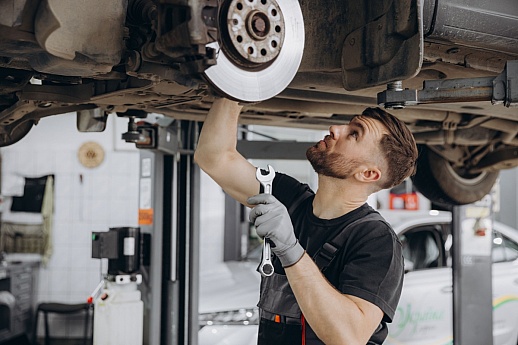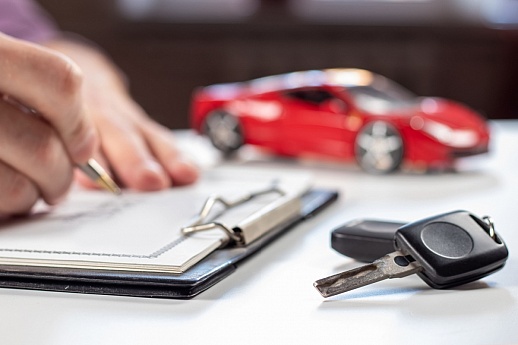How To Ensure Your Dog's Safety in The Car
Embarking on a journey with our dogs turns every drive into a shared adventure, yet it brings a big responsibility: ensuring their safety in a car. My eye-opening moment came during a trip with my dog, Dante, whose sudden leap into my lap while driving highlighted the risks our furry friends might pose on the road.
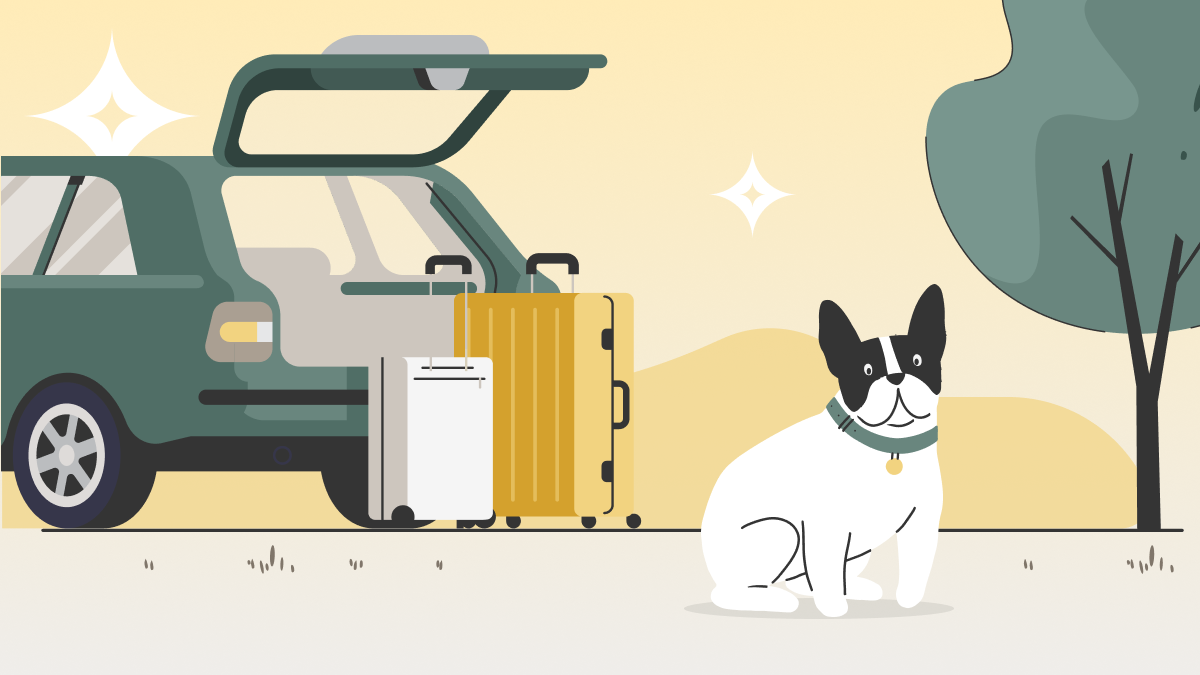
As both a dog owner and a financial coach, I've found that ensuring the comfort and safety of our pets during car rides doesn't have to strain our wallets. This article is designed to guide you through the safest ways to transport dogs in the car, from choosing the right restraint to planning for breaks. We'll explore how to make every car journey safe and enjoyable for you and your Dante alike.
How To Secure Your Dog in The Car
There are numerous safety devices and precautions you can take to protect your dog while traveling, depending on their size and preferences. Let's look into selecting the right restraint and implementing safety tips to make every journey with your dog a smooth one.
Secure Your Dog Properly
When it comes to securing your dog in the car, selecting the right type of restraint ensures both safety and comfort during your journey. Here are the most popular restraint options:
- Harnesses distribute force evenly across the chest and back in case of sudden stops, reducing the risk of injury. They allow for some movement but keep your dog securely in place. Harnesses are ideal for medium to large dogs due to their strength and size. The main drawback is that not all harnesses are created equal, so it's important to look for crash-tested models that guarantee dog safety in a car.
- Dog seat belts are harnesses with loops that allow the seat belt to clip into the vehicle's buckle. They offer a bit more flexibility but ensure safety during a collision. This setup is suitable for dogs that are calm and don't attempt to move around too much, as it prevents them from jumping into the front seat or out of the window.
- Crates provide the most security, ensuring that your dog stays in one enclosed area. They're especially beneficial for anxious dogs as they can create a sense of security. The crate should be large enough for your dog to stand, turn, lie down comfortably and be securely fastened to the vehicle to prevent shifting. Crates take up more space, but they're ideal for small dogs and particularly useful for long journeys.
To acclimate your dog to their restraint, start by introducing the harness, seat belt, or crate in a familiar, non-threatening environment like your home. Use treats and praise to create positive associations with the restraint.
Practice short, enjoyable car rides to dog parks to get your dog used to the sensation of being secured. Rewarding your dog after securing them reinforces the positive experience, helping them feel more at ease during travel.
Keep Dogs in the Back Seat
For added security and to prevent your pup from jumping into the front seat, you can install back seat dividers to ensure that act as physical barriers between the back and front seats. These are excellent additions to harnesses or crates for added security.
Keeping your dog in the back seat of the car shields your pet from front-seat airbags, which can be harmful to pets during deployment in a crash. This setup not only safeguards your pet but also significantly reduces your distractions, allowing for better concentration on driving.
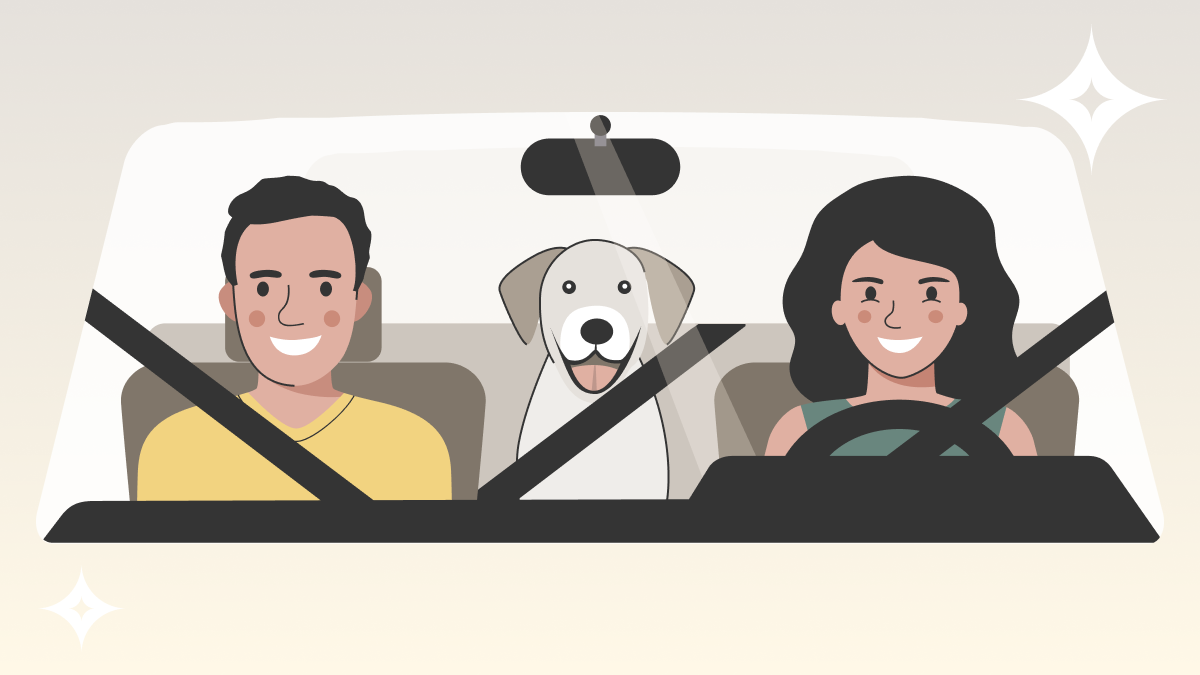
The choice between using a divider alone or in combination with other restraints should be tailored to your dog's size, behavior, and specific travel needs. For calm dogs that are content to lie down and relax, a divider alone may suffice. However, for more active or anxious pets, pairing a divider with a harness can prevent them from roaming and offer a sense of security.
Use Window Shades and Ventilation
Using cost-effective window shades and ensuring proper ventilation can significantly improve your pup's comfort level, helping them be more relaxed and contributing to safer driving.
My experience with Dante has shown me that window shades provide him with a cool and shaded space, mitigating risks like overheating. In turn, it minimizes his movement, fidgeting, or barking, resulting in less distracted and safe driving for me.
With window shades, you have options: static cling or retractable ones. Static cling shades are easy to install and remove, making them ideal for temporary use or for drivers who prefer a flexible solution. They're effective at blocking sunlight but can be limited in size options.
On the other hand, retractable shades offer more permanent solutions with the ability to adjust the level of coverage for different sunlight intensities. They're great for consistent use but may require a more involved installation.
Proper ventilation also plays a considerable role in maintaining a comfortable atmosphere for a dog in the car, particularly on warm days or during extended trips. Ensuring a steady flow of fresh air, whether through slightly opened windows or an adjusted air conditioning system, helps keep Dante at ease.
Plan for Breaks and Rest Stops
In financial planning, we focus on preparation and foresight, approaches that are equally beneficial when traveling with pets. From my journeys with Dante, I've learned that scheduling breaks and rest stops enhances his well-being and keeps my dog relaxed throughout the ride. This prevents him from getting restless and moving around too much or distracting me from driving safely.
These scheduled stops provide Dante time to stretch, hydrate, and relax, which, in turn, smooths our travel experience. For optimal comfort and safety, it's advisable to schedule breaks every two to three hours during long trips, adjusting the frequency based on your dog's age, anxiety levels, or medical needs.
Avoid Loose Objects
Items like water bottles, small electronics, and even everyday essentials such as umbrellas or books can become projectiles during sudden stops or collisions. This not only poses a risk of injury to both pets and passengers but also can lead to distractions for the driver, increasing the likelihood of accidents.
To mitigate these risks, it's advisable to store loose items in compartments, the trunk, or under seats where they are less likely to move. Using car organizers or cargo nets can also help keep items secure while on the move.
Be Prepared for Emergencies
When traveling with a companion, you should always be prepared for the unexpected. Equipping yourself with an emergency kit containing water, food, a first-aid kit, and necessary medications ensures you can address your pet's immediate needs during emergencies on the road. For long drives and road trips, you should know the locations of veterinary services along your route.
This preparation allows drivers to remain focused on the road, knowing that solutions for potential pet-related emergencies are readily accessible.
Pet Insurance Considerations
Hitting the road with a furry co-pilot like Dante adds a layer of joy to every journey, but it also introduces unique risks, particularly when it comes to driving-related accidents. Yet, as we cruise down the highway, I'm always conscious of the "what-ifs." What if we are involved in an accident?
That's where pet insurance steps in, not as a maybe, but as a must-have, specifically designed to cover injuries that can result from these accidents. Looking for pet insurance means pinpointing policies that specifically cover injuries from a variety of driving-related accidents, like emergency vet visits to more serious treatments.
Insurance can also cover minor incidents, like when Dante eats something he shouldn't during a pit stop or if he experiences stress or anxiety from a hectic ride.
Generally, pet owners might expect to pay anywhere from $20 to $70 per month. This investment covers a range of driving-related incidents, especially if you frequently take your furry friend out on the open road.
While this might seem like an added expense, it pales in comparison to the potential costs of emergency treatments following a car accident, which can easily run into the thousands. Perhaps the most significant return on investment is the peace of mind it offers, knowing that I’m prepared for any mishap.
What Is The Safest Way to Travel With a Dog in a Car?
The safest way to travel with a dog in the car is to securely place them in a crate in the back seat or enclosed trunk. Make sure to strap in the crate to ensure that it doesn’t tip over or slide around. This option is usually the safest for dogs who are anxious or older and more susceptible to injuries.
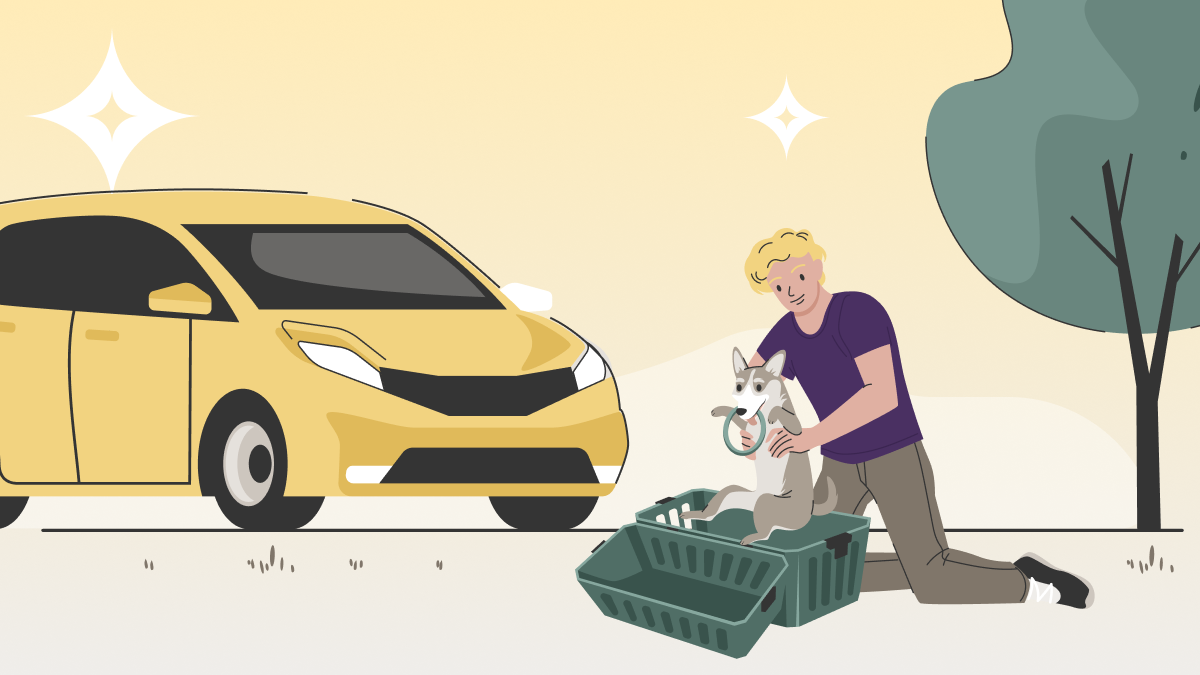
If your dog is accustomed to being in the car and isn’t the type to move around often, you can opt for a harness or car seat belt. The harness or seat belt can be combined with a car divider to reduce the likelihood of your pup wanting to ride in the front with you.
Can Dogs Sit in the Front Seat of a Car?
While it might be tempting to have your furry friend sit up front with you as your co-captain, it is strongly discouraged due to the risk of injury. Also, depending on the state, you might face legal fines.
In the event of an accident where the airbag deploys, your dog could be severely injured. To ensure dog’s safety in a car, it is best to strap them in with a harness in the backseat or place them in a crate.
While there are no federal regulations regarding driving with dogs in the car, three states (Hawaii, Rhode Island, and New Jersey) have laws that require pet owners to restrain their companions with harnesses or seat belts.
Also, most states have laws regarding distracted driving, which can often result from having pets in the front seat, roaming in a moving vehicle, or in your lap. Almost every state outlaws driving with a pet in your lap, as it is considered a distraction.
How to Stop a Dog From Moving Around in the Car?
Of course, the best way to stop your dog from moving around in the car is to restrain them with a harness, crate, or seat belt. But for a more relaxed drive, here are some additional ways you can stop your dog from moving:
- Cover the Crate or Carrier: If using a carrier, covering it with a light blanket can reduce visual stimulation and help some dogs settle during the ride.
- Use Calming Supplements or Scents: Use vet-approved calming supplements, natural remedies like pet-approved CBD treats, a pheromone diffuser, or a spray that mimics calming maternal pheromones.
- Bring Comfort Items: Bring along a favorite toy, a blanket that smells like home, or a piece of your clothing to create a comforting environment in the car.
- Enroll in a Professional Training Class: A professional trainer can teach you how to reinforce calm behavior and manage anxiety based on your dog's temperament and specific challenges with car travel.
- Start Desensitization and Counter-Conditioning: Gradually expose your dog to the car in a non-threatening way, starting with sitting in a parked car without starting the engine, then short trips around the block. Slowly increase the duration and pair each step with positive reinforcement, like treats and praise, to build a positive association with the car.
Car Safety for Small Dogs
Embarking on a road trip with your smaller-sized companion, start with a snug, crash-tested harness tailored for smaller breeds. It will keep them securely anchored, ensuring they aren’t sliding around in the backseat.
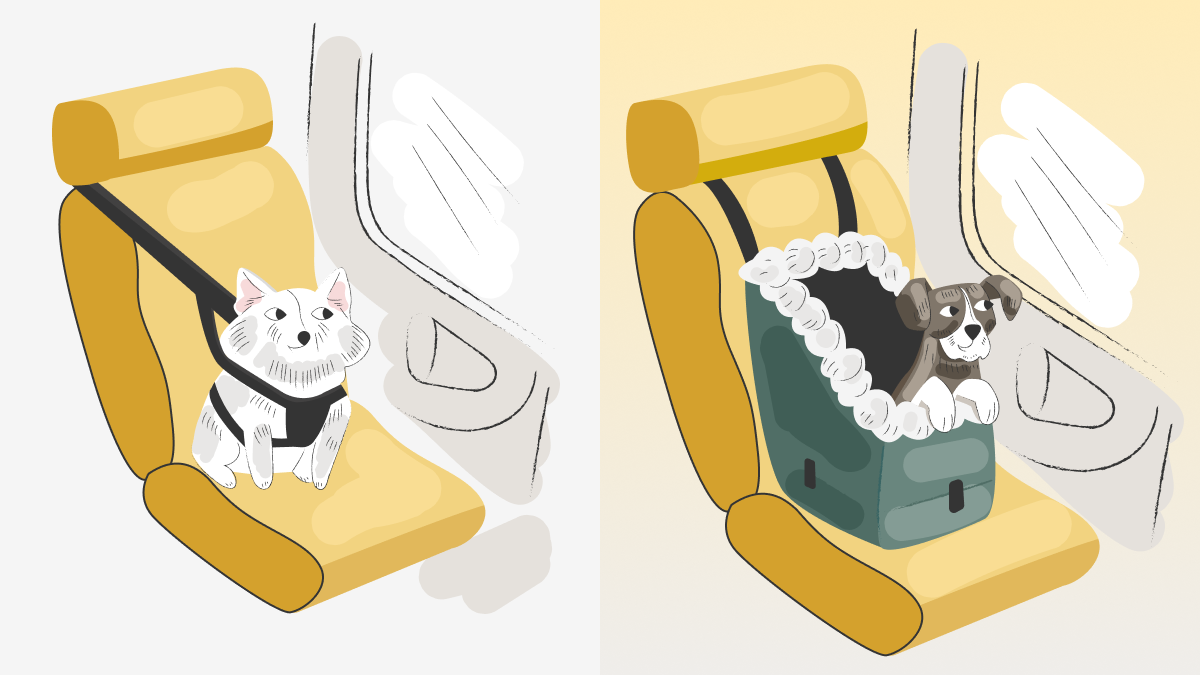
For curious tiny explorers, consider a hanging dog car carrier. It's like a personal travel pod that keeps them off the seats and provides a clear view outside. It offers stability and a sense of security that can significantly reduce travel anxiety. Plus, its elevation helps manage motion sickness.
Bottom Line
Ensuring our dogs' safety and comfort during car travel involves appropriate restraints, regular breaks, and a comfortable environment. Tailoring travel strategies to meet the specific needs of pets ensures their protection.
Additionally, this is an opportune moment for pet owners to review their insurance policies regarding pet safety during travel. Insurance can provide an extra layer of security, covering unforeseen veterinary expenses resulting from travel incidents.
FAQ
For more dog safety-related car travel tips and information, check out our frequently asked questions and answers below:
How Can I Minimize My Dog's Stress During Car Rides?
Familiarize your dog with the car and their restraint in a positive, stress-free manner before embarking on long trips. Keep the environment inside the car calm and comfortable, use window shades to protect against heat and glare, and avoid feeding them a large meal before traveling to prevent motion sickness.
What Should I Do if My Dog Gets Carsick?
To manage carsickness, try feeding your dog a light meal a few hours before the trip. You can also ask your veterinarian about motion sickness medication for dogs. Keeping the car cool and well-ventilated and limiting your dog's view outside the car can also help reduce nausea.
Can My Dog Ride with Their Head Out The Window?
While many dogs enjoy this, it's not recommended due to the risk of injury from debris or being hit by objects outside the vehicle. It's safer to keep your dog inside the car with windows only partially down to allow fresh air without the risk.
PetSafe. "Walk Along Outdoor Harness Acclimation." Accessed Feb. 13, 2024.
Centers for Disease Control and Prevention. "Distracted Driving." Accessed Feb. 13, 2024.
VCA Animal Hospitals. "Motion Sickness in Dogs." Accessed Feb. 13, 2024.

